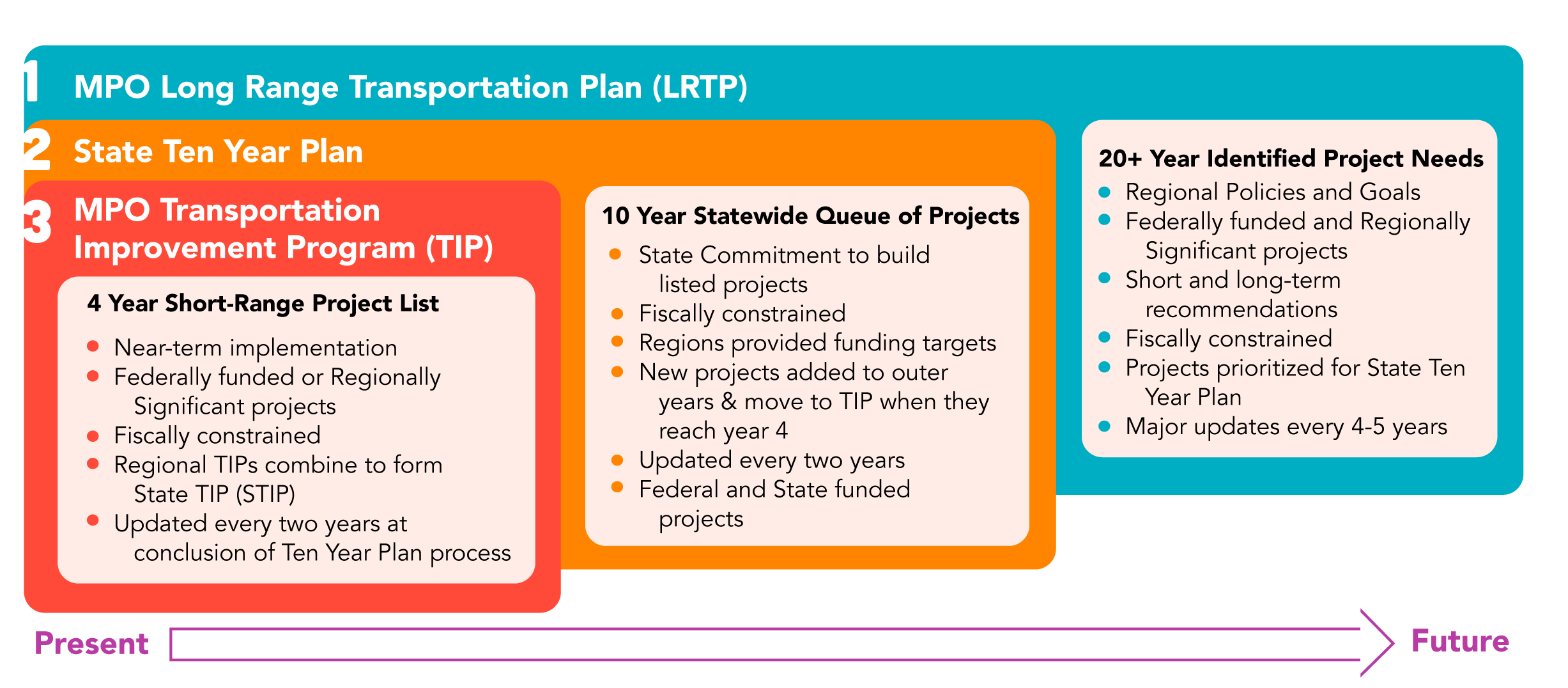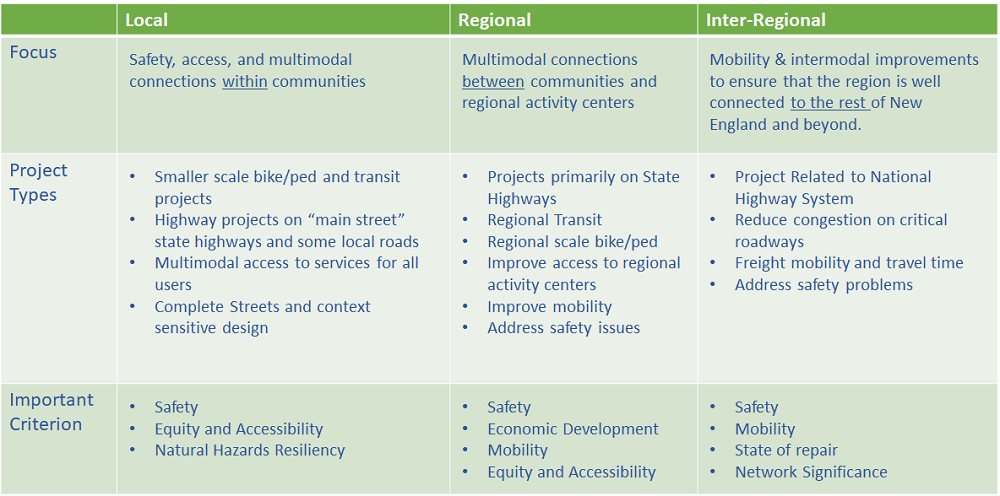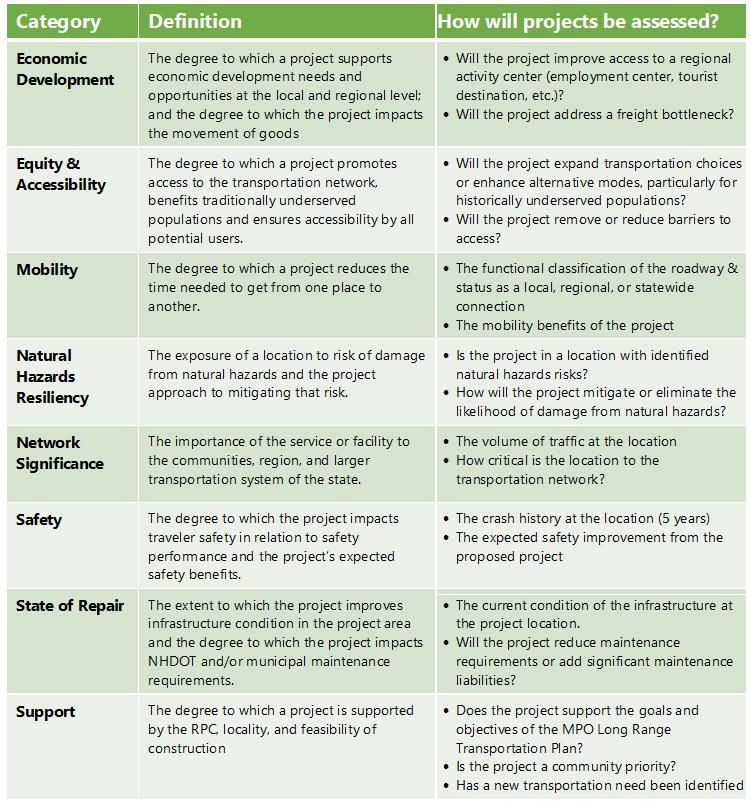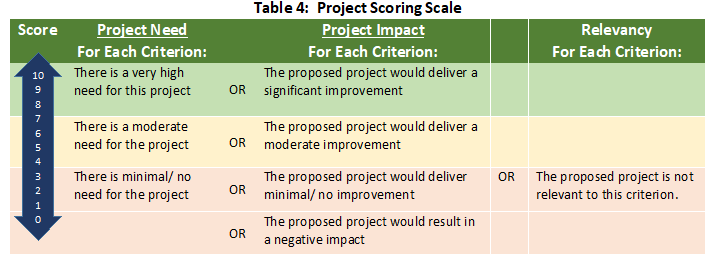2024-25 Project Solicitation & Selection Process
RPC is currently evaluating the projects included in the Long Range Transportation Plan and establishing regional priorities for the next iteration of the State Ten Year Plan. This is an opportunity for direct community involvement to ensure that local transportation issues and needs are identified. In that regard, by June 5, 2024, community assistance is requested to:
- Identify transportation issues and needs that are important to your community.
- Review the LRTP projects in your community and provide updated information, if available.
- Submit new transportation project proposals for consideration.
- Establish the relative priority of each project to your community. If the community is no longer interested in a project, please provide that information as well.
2024-2025 Project Application Guidance
Regional Projects included in the 2023-2026 TIP (As of 04/02/2024) - This included for reference as these projects are already approved, funded and are in the process of being implemented.
2045 Long Range Transportation Plan Project List (As adopted 2/2023) - Projects are listed alphabetically by community. Projects with "TYP" in the "Scale" column are already included in the State Ten Year Plan
queue of projects and will not be prioritized as part of the current
process. All of these projects are included in the Transportation Project Portal linked above.
Current State Ten Year Plan
on (NHDOT Website) - This is the NHDOT website providing the details on
current and past Ten Year Plans including drafts at various stages of
approval, public hearing details, and other considerations. The
2023-2032 Ten Year Plan is the most recent approved however the
2025-2034 Ten Year Plan is anticipated to be approved by the legislature
and signed by the Governor in summer 2024.
Draft 2024 Statewide Project Selection Criteria Documentation:
The set of Statewide Project Selection Criteria serve as the basis for
establishing priorities for the State Ten Year Plan. Additional Details
on how RPC utilizes these criteria in the decision-making process are
below. This information is currently being finalized and will be updated in late April, 2024.
Transportation Project Portal and Application Form
To support the solicitation process and provide an easy method of reviewing and submitting projects, RPC has established a Transportation Project Portal that includes modules for submitting new proposals as well as viewing information on existing projects. Instructions for utilizing the portal are below. It is suggested that each community select one person to input/update the project data to avoid duplication. The portal can be accessed via the url below:
To add new projects: RPC Project Application Form
This form is the submission form for new projects for the RPC Long Range Transportation Plan. Most of the questions are largely self-explanatory or include help text. All questions are required and if a field is not applicable to the project, please type "Not Applicable." Several of the questions reference submitting additional documentation for the project such as cost estimates, conceptual designs, and others. There is a space in the "Supplementary Information" section of the form for attaching this documentation. Please note that a project can be submitted without a cost estimate however RPC will not be able to include projects without cost estimates in those considered for the State Ten Year Plan.
To edit existing projects: Transportation Project Portal
All projects in the MPO Long Range Transportation Plan are included in the Transportation Project Portal, including those in the State Ten Year Plan. Exceptions may include projects in the current draft Ten Year Plan. Changes to the software have left RPC unable to allow users to edit projects. If a community or agency has identified project changes that need to be included, please communicate with the transportation team at RPC (transportation@therpc.org) and we can coordinate the updates. The goal is to maintain current information on all projects in the LRTP in a single location that is available to the public and to provide the communities an easy method for updating project information at any time. Changes are tracked and periodically backed-up to minimize data loss.
Transportation Project Portal Instructions
If you know of a project that your community has submitted but it is not included on the map, please contact RPC staff.
Overview of the Project Solicitation & Selection Process
A blend of State and Federal processes that provide the transportation planning structure for New Hampshire. Federal regulations require MPOs to adopt project specific Long Range Transportation Plans (LRTPs) and short-range Transportation Improvement Programs (TIPs). Additionally, the MPO, as a Regional Planning Commission, plays a legislatively mandated role (NH RSA 240:3) in establishing priority projects for the State Ten Year Plan. These three documents form the backbone of the transportation planning process in New Hampshire and provide a path for projects to move from concept (MPO LRTP ①), through project development (State Ten Year Plan - ②), and to implementation (TIP/STIP - ③).The Ten Year Plan is required to be updated every two years and the TIP and LRTP have been incorporated into this cycle to merge the state and federal processes with the MPO drawing project priorities from the LRTP to feed into the Ten Year Plan, and the first four years of the most recently approved Ten Year Plan serving as the basis from which the TIP and STIP are constructed.
Click here for a 2-page summary of the Transportation Planning & Project Selection Process.

The MPO follows the general structure and time frame below to establish Ten Year Plan priorities:
Solicitation for Projects (Summer – Even Years): The MPO requests projects from communities and transit agencies during the summer of even years. New proposals are compiled with existing projects already in the MPO LRTP.
Project Development and Classification (Fall – Even Years): Projects are classified into three categories based on the scale of benefits (local, regional, inter-regional - see below), project information is reviewed, and costs are updated where feasible. Those projects that are not ready (no cost estimate for example), or not needed at this time, are set aside for consideration in future cycles. The remaining projects proceed to evaluation by the project selection criteria.
Evaluation & Draft Priorities (Fall – Even Years): A set of project evaluation criteria developed by NHDOT and the nine regional planning commissions are used to prioritize projects for inclusion in the Ten Year Plan. These fifteen criteria address eight areas of consideration: Economic Development; Equity, Environmental Justice, & Accessibility; Mobility; Natural Hazard Resiliency; Network Significance; Safety; State of Repair; and Support, and an overview of each is below. The MPO evaluates each project against these criteria and establishes a draft priority for each of the three project groupings (local, regional, inter-regional). The top projects from each group are then presented to the MPO to constrain to a budgetary target as a candidate project list for evaluation by NHDOT. The specific process that the RPC uses is included in the section below providing guidance and detailing the current iteration of this cycle.
NHDOT Engineering/Cost review of Candidate Projects (Winter – Odd Years):The list of candidate projects is submitted to NHDOT along with documentation for engineering and cost estimate review. This is intended to identify projects with infeasible scopes or wildly inaccurate cost estimates prior to setting a finalized list of priorities from the regions. This will help avoid the multiple revisions that were made last time and ensure that what is proposed in the end is consistent with the budget target.
Finalize list of Ten Year Plan Priorities (Spring – Odd Years):Once NHDOT has completed the review of candidate projects, the information is passed back to the MPO for establishing final priorities and constraining to the budgetary target. NHDOT has committed to incorporating MPO priority projects as presented into the draft Ten Year Plan up to the budget target amount of funding. The projects still must be vetted through the remainder of the Ten Year Plan adoption process along with all others in the document.
NHDOT produces a draft of the Ten Year Plan during the summer of odd numbered years and begins the wider public involvement process through the hearings held by the Governor's Advisory Council on Intermodal Transportation (GACIT) that occur in September and October. These are followed by a revised draft Ten Year Plan that is approved by GACIT and sent to the Governor for review in December. In January, the Governor revises the GACIT draft and submits the document to the Legislature for review and approval which generally occurs during the spring session in even numbered years. The Ten Year Plan bill is signed by the Governor during the summer of even numbered years and the plan goes into effect at that time.
Project Selection Process Detail
Communities and regional transit agencies are asked to submit projects by a certain deadline that may change from cycle to cycle. All projects submitted to the RPC will be incorporated into the Long Range Transportation Plan (LRTP) provided they align with the vision, goals, and objectives of the LRTP. Projects are then prioritized to be added to the State Ten Year Plan. The project prioritization process involves several steps:
PDF of Project Selection Process
Project Development & Classification (Sping-Summer)
All projects in the LRTP are classified into three categories based on the scale of impacts and benefits (local, regional, inter-regional - see Table 1 below). Information is reviewed and updated for projects already in the LRTP and new projects are classified and added to the database.
Table 1: Project Classification

Determining Feasibility (Spring-Summer)
For each project, the MPO must make a determination of feasibility and eligibility for funding in the Ten Year Plan. Several aspects of each project are considered:
- The project must have a defined scope and cost estimate.
- There is a clear need for project in the next ten years.
- The approach to addressing the transportation issue is reasonable given existing resources.
- The project is eligible for federal funds and is likely to receive necessary resource agency permits.
- There is clear evidence of local support/priority.
Projects that are not eligible for the State Ten Year Plan generally remain in the Long Range Plan as other sources of funding are sought.
Scoring Projects (Summer)
Each project is measured against the set of criteria that have been agreed upon by NHDOT and the nine New Hampshire Regional Planning Commissions. These criteria are grouped into the eight categories shown in Table 2 and the criteria are weighted for consideration according the distribution shown in Table 3. The weights for the criteria will be determined through a priority setting exercise at the RPC TAC meeting (Spring even numbered years) and will be added to the information at the top of this page at that time. Scores are assessed using current understanding of the project scope, available data, and best judgement to apply the selection criteria using the scale in Table 4. Projects are evaluated based on understanding of both need and expected impact, and those with higher need and/or higher impact will receive more points. Once each project is given a score for each criterion, the total weighted score for each project is calculated based on the weights and classification of the project shown in Table 3. Current information on the criteria and current scoring weights for each are included under the current application cycle guidance at the top of the page.
Table 2: Current Project Selection Criteria

Table 3 will show the project selection criteria weights and will be added once those details are available

Prioritization (Summer-Fall even numbered years)
Projects will be assessed and scored by RPC staff using the weights for each criterion at each scale and the results are brought to the MPO TAC meeting during summer of even number years for discussion and candidate project selection. Staff present the top five (at minimum) local, regional, and inter-regional projects to the TAC for consideration as candidate projects for the next Ten Year Plan. From those projects, the TAC selects a draft list of candidate projects recommended to the MPO Policy Committee, up to the regional budget target plus one to two additional projects. These projects are reviewed by a team of consultant engineers who develop a draft scope and cost estimate for each. The TAC reconvenes in the fall to select a final set of candidate projects to recommend for the Ten Year Plan. The MPO Policy Committee November meeting (even number years) includes discussion and approval of a final candidate list of projects to submit to NHDOT for engineering and cost review.
NHDOT Review (November Even Years – February Odd Years)
By mid-November even numbered years, the MPO must submit a single list of candidate projects to NHDOT for engineering and cost review. NHDOT examines both the feasibility of the proposal as well as the reasonableness of the cost estimate. Some adjustments to the project cost or scope may be recommended and a project review is returned to the MPO in late-January or early-February of odd numbered years.
Final Prioritization (February – March Odd Years)
NHDOT project cost and engineering review will be completed in January/February of odd numbered years and recommendations returned to the MPO. The MPO TAC will meets in February of odd numbered years to make a final recommendation on project priorities to the MPO Policy Committee. The Policy Committee March meeting during odd numbered years includes approving the MPO recommendations for the current State Ten Year Plan cycle and these will be submitted to NHDOT by April 1 of each odd numbered year.

